Twoodo Experience: How to increase user activation from 2% to 30% in 10 steps
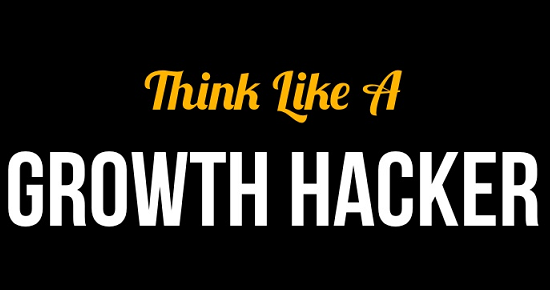 A week ago, we discussed various ways to reduce churn and increase user activation in our SaaS service. Then we came across the article “How we increased our activation rate from 2% to 30% in 10 steps”, published on TheNextWeb.com . The article is written by David Arnaud, development director and co-founder of Twoodo . The article seemed to us so useful and interesting that we gladly translated it for publication in the blog of our project on Habré. The story in the article is from the first person.
A week ago, we discussed various ways to reduce churn and increase user activation in our SaaS service. Then we came across the article “How we increased our activation rate from 2% to 30% in 10 steps”, published on TheNextWeb.com . The article is written by David Arnaud, development director and co-founder of Twoodo . The article seemed to us so useful and interesting that we gladly translated it for publication in the blog of our project on Habré. The story in the article is from the first person.One of the most important lessons that I have learned over the past few months is that when creating a SaaS company one should not lose sight of the data obtained on the basis of opinions and assumptions just because it is impossible to confirm them with numbers. This is especially true if you follow lean methodologies. Try to always listen to customers - especially if you are serious about increasing activation , that is, the number of users who recognize the value of your product during the first session.
Saying “I want” is, of course, easy, but how to realize our plans?
')
I would like to share with you tips, tricks and tools that we used to develop an effective scheme for receiving feedback - despite the fact that we were still working in a closed beta version and could not boast of huge amounts of traffic (about 200 unique visits). in a day).
The feedback we have gathered has greatly helped us increase user loyalty and make contact with customers. Thanks to the feedback, we were able to understand which functions our first customers really needed.
1. We decided to launch a closed beta version.
For the first three months, the Twoodo service was only available in closed beta mode. The question of whether a SaaS startup should be open to everyone from the very beginning should be quite relevant now. However, we decided to use the opportunities in the beta version. The main argument was that restricting access to the service would allow us to refine the interface, site and functionality.
In addition, from the very beginning, we wanted to clearly indicate which segment of users our activities are focused on. This will be discussed below.
In the first month of beta testing, we rather strictly selected people who could use our product. To be able to try our tool, they had to:
• stand in the electronic queue;
• fill in the questionnaire;
• chat with us via Skype (however, after a while we eliminated this item, since we received a sufficient amount of information from the questionnaire).
2. Creating a questionnaire
We created the button “add me to the electronic queue” as the main call to action on our landing page .
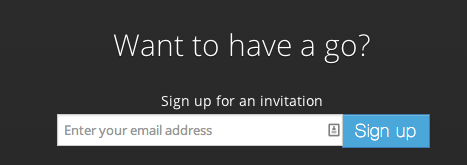
After registration, the user received an email from us asking them to complete a questionnaire that we created using Google Drive . Without compliance with this condition, the visitor could not access the Twoodo.
Honestly, the questionnaire was quite long, but it was a premeditated move. Using the questionnaire, we deliberately delivered to the user certain inconveniences.

However, you will be surprised to know how many visitors have filled out the questionnaire. We were amazed - more than 50% of respondents answered all questions. Of course, it was not easy, but with the help of such a detailed questionnaire we obtained a lot of invaluable information, such as:
• types of users who were attracted to our product;
• the number of people in their team;
• industry affiliation, place of work;
• the tools they use;
• inconvenience when working with other tools;
• some expectations, like the features they want to see with us, etc.
When we realized how much information the questionnaire gives us, we refused to communicate via Skype as the final stage of accessing the service.
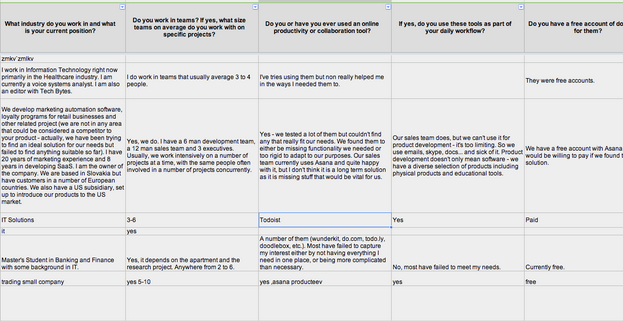
But at the initial stage, when Skype call still existed, we had the opportunity to talk with them live and ask all the questions we are interested in. Subsequently, we could use this information to make the activation process for these users easier.
At that time, the number of users who realized the value of our product in the first session was 2%, and the registration process was rather erratic.
3. Offer to chat on Skype!
The next step was a letter in which we thanked for filling out the questionnaire and invited to a 10-15-minute webinar on Skype.
We pursued three main goals:
1. Since our activation process was still not up to par, we thought that live communication would be able to liberate the user.
2. We could find out what problems our customers encountered when they first used the tool;
3. We have the opportunity to build a trusting relationship with the user.
We tried to adhere to the following plan:
1. 5 minutes: familiarity with the user, talk about his work and the problems he faces.
2. 5 minutes: a story about Twoodo with a focus on the difficulties that he experiences when working with other tools.
3. 5 minutes: questions and answers, informal communication.
However, in practice, webinars usually lasted more than 15 minutes. At first we used Skype, but after a while we switched to Zoom.us. Collaboration on one screen in this program is much more convenient than in Skype, and this service can be used for free for up to 45 minutes.
With the help of webinars, we immediately realized that our user interface is too complicated . We gave too much information that was hard on. This prompted us to create a simplified interface.
Although not all users could find time for the webinar, those who did communicate with us, provided us with useful and relevant information. She still uses Twoodo and is happy to share with us her opinion about the service. Feedback from users continues to come.
By simplifying the user interface, we increased activation to 8%.
However, this result did not impress us. We could not understand - why the remaining 92% are not enthusiastic about our product after the first use?
4. In-app messages
On average, users will familiarize themselves with your instrument within 1-2 minutes, and then either start using it or go search for another. It is difficult to overestimate the importance of feedback during the first use of the service - it is she who sometimes plays a key role in whether the user will like your product.
What are their preferences? What annoys them? What is incomprehensible to them? Do they like colors? Isn't there a lot of text? They will notice this big red button to press? To increase activation, you must clearly know the answers to these questions.
Tools like intercom.io (which we use as well) will help you correctly place in-app messages that will appear when you consider this to be the most optimal. Here is how it looks on our website:

Close-up:
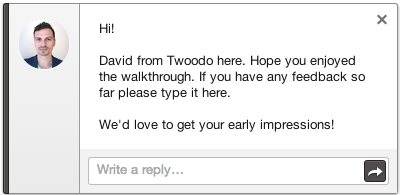
We have a message immediately after the user has finished a four-page acquaintance with the site (or pressed the “skip” button) and started working with the tool. Customers see a picture of David and a short message. All they have to do is click on the input field and give their opinion.
The user does not need to make almost any effort to send a message (as opposed to emailing or using the contact form), so we receive a lot of feedback every day. In addition, with the help of user comments, we were able to sample the most common problems and quickly fix them. Here are some examples of feedback received:
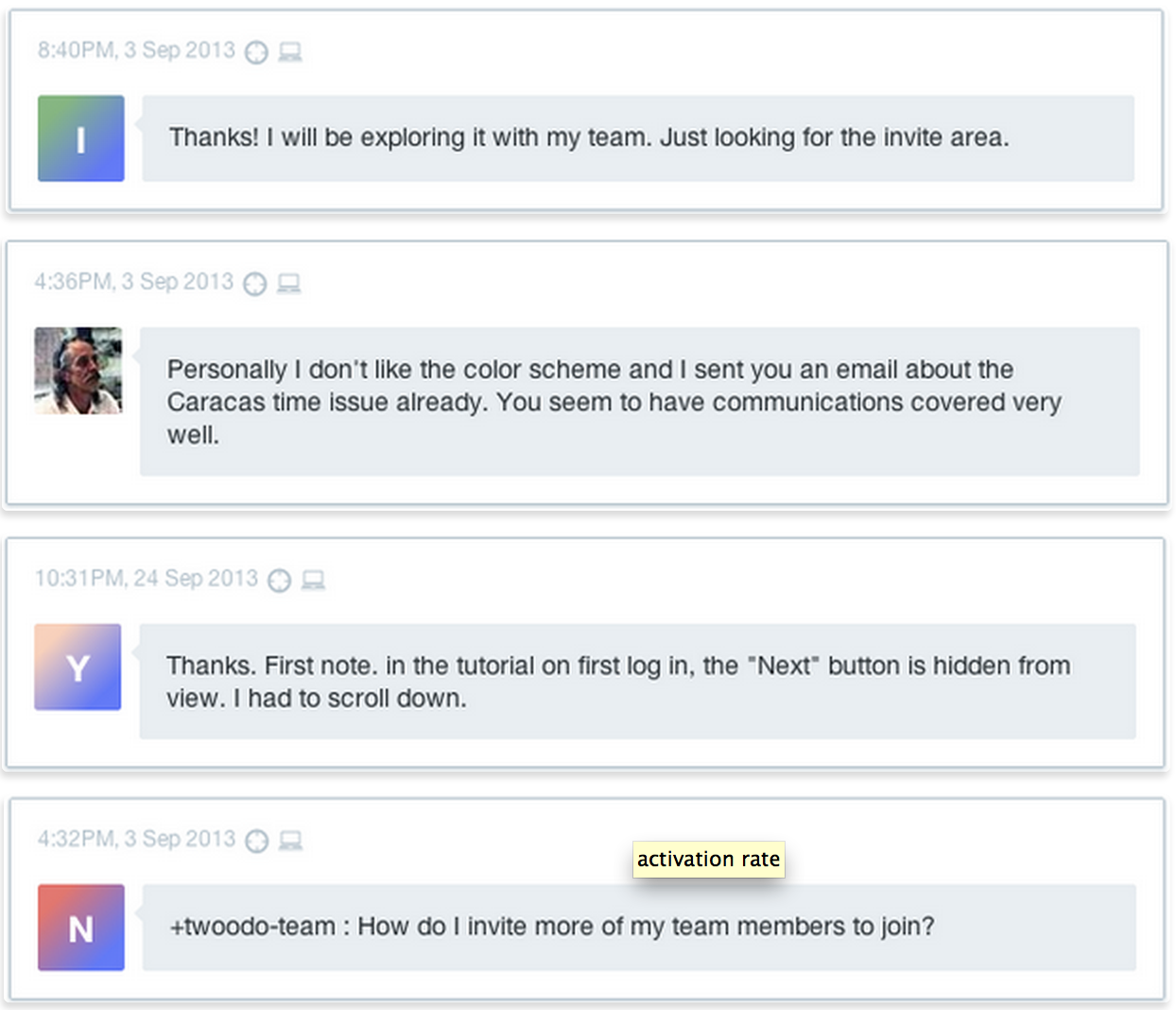
We created a list of reviews and grouped them into categories, trying to solve all the problems as they arrived, but giving preference to those that were mentioned most often.
As a result, we learned tons of information:
1. Getting to know the product was too complicated and confusing, so we should simplify it.
2. Users did not know how to invite friends to try the product.
3. Some features seemed more complicated than others.
The list goes on ...
We corrected all these shortcomings and gradually began testing new solutions. In addition, we began to conduct usability testing through www.usertesting.com . At this stage, we also started developing a FAQ on Google doc for use in the near future.
After a month of testing and improving the settings, activation was 17%.
5. Installing online chat
Another effective way to get feedback from users is to install an online chat. We chose the Olark service because of the simple installation and the free version (hidden on their tariff page) up to 20 chat sessions per month.
If over a month you have more than 20 online sessions with users, I would recommend using the paid rate.
We installed Adium and linked the Olark online chat with Adium accounts. Each user tends to log in to Adium as soon as he notices that we are online. We ended up with this because it was too distracting to some representatives of the technical teams, but at least one person from our team was always online, so it was worth it.
We received a lot of user feedback via chat. We were also able to figure out what was not clear when using the site, and use this information to create the FAQ section.
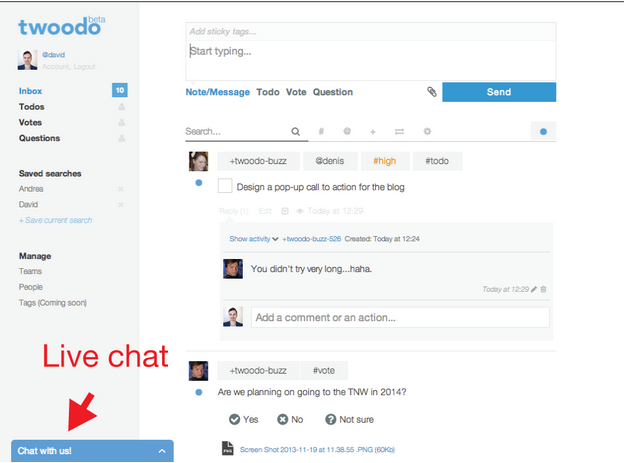

We noticed another interesting feature: we had the opportunity to see everyone who visits the site at any time, using a pop-up with a notification appearing on the screen. Honestly, at first it really helped, but then it became annoying.
However, it was one of the real-time analytics tools that you can use to communicate with the user.
At this stage, activation increased to 19%.
6. The message that arrives to non-activated users the next day.
81% of users who registered on our site provided a good initial feedback in relation to in-app messages, but at that time they did not use our tool yet. That is, they have registered, but have not yet activated their account - which means they have not yet felt the full benefits of our service. So instead of endlessly guessing, we decided to ask the users what stopped them?
With the help of Intercom, we have created an automatic letter that will be sent to “non-activated” users the next day after registration. As you can see, in the letter we also advertise the application for the iPhone.
This is what our message looks like:
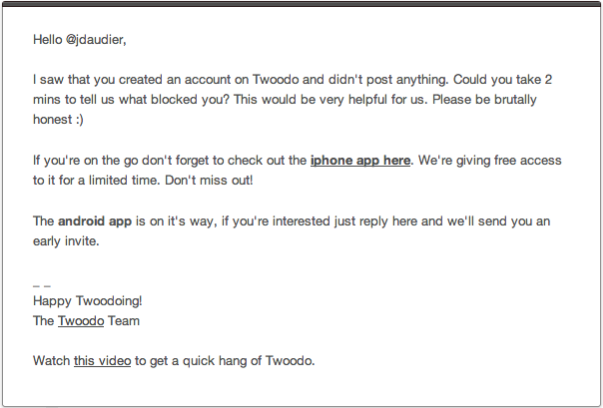
First of all, we learned that most users are just too busy. Some representatives of our team thought that this means that "they are quite satisfied with other services." Others assumed that it was necessary to continue to influence users, motivating them to activate their account, before it was too late.
7. “Drip” email marketing

We understand the following: if you want to motivate customers to start using your tool, you need to remember one simple rule. Many users register, but do not start working with your service simply because they do not have enough time for it. We implemented e-mail marketing, which unobtrusively and regularly reminded us of an “abandoned account” with the help of drip email marketing, which helped us a lot . We implemented our ideas with Intercom.
Using messages created on the basis of user behavior, as well as sending them every other day, 3 days, 10 days and 25 days, we were able to increase activation to 28%.
We are still working on improving drip email marketing and we hope that we can improve performance by up to 40% in the near future.
8. Using our tool
Twoodo is a collaboration service. That is why we can use our own tool to interact with users and increase the number of loyal customers.
We created a team called + twoodo-team. Users can simply send us a message, and we will definitely see it. Each member of our team has the opportunity to answer questions from users and just chat with them. This creates a feeling of openness, and therefore we maintain close ties with our customers.
Later we changed the in-app message text to explain to users how to contact us directly on Twoodo. It was great because customers can use the service to contact us, and we have the opportunity to respond and communicate with them. If a similar function is built into your service, enable it right now.
At that time, activation was 30%.
9. Contact collection form
As with any site, we have a contact collection form, the link to which was located at the bottom of the page. I would say that the contact collection form is good at the first stage of work. However, since we have already used all of the above tools, users fill out the form quite rarely, because for this you need to make a lot of effort. And so many messages come to us every day.

10. Creating a community
We like sites like Stackoverflow and Quora . They represent large-scale communities where you can find answers to current questions. We are also thinking about creating a similar community that will serve as our FAQ + group + customer support.
findings
It's time to take stock: each user has his own preferences, so each of them will communicate with you differently and in due time. I advise you to pay close attention to developing high-quality feedback so that the client will be delighted with your tool.
And do not forget that the most important element of the sales strategy of a SaaS company is not only the desire to hear the client and offer him constant support.
Source: http://thenextweb.com/dd/2014/07/13/increased-activation-rate-2-30-10-steps/
Article editor - Aida Legrand, co-founder of Witget.com
Source: https://habr.com/ru/post/230301/
All Articles